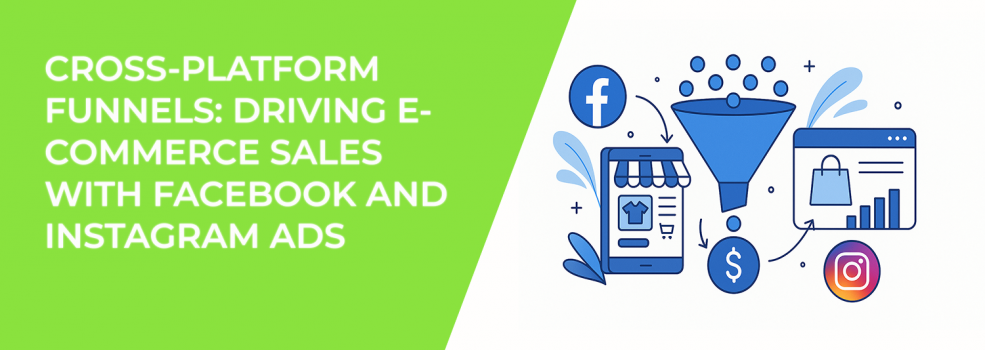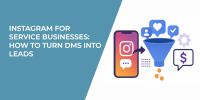Running Facebook and Instagram ads separately is fine, but connecting them into one funnel is where the magic happens. Why? Because buyers don’t make decisions in one sitting. They scroll during lunch, check Instagram before bed, then maybe add something to their cart on the weekend. Each step in that journey is an opportunity — if you build a funnel that meets them where they are.
When your ads work together across platforms, they stop feeling like scattered promotions and start becoming a guided path. Think of it as storytelling. Each ad continues the narrative, nudging people closer to “Buy Now.”
Here’s how to structure a cross-platform funnel that keeps e-commerce shoppers engaged from the first impression to the final checkout.
Why Cross-Platform Funnels Are a Must for E-Commerce
People don’t stay on one platform anymore. They jump between Facebook and Instagram several times a day. If your brand only shows up on one, you’re missing half the conversation.
Facebook’s strength lies in audience targeting and varied ad formats. You can reach cold audiences based on interests, behaviors, or lookalikes, and you can serve them longer-form content like videos or carousels. Instagram, on the other hand, wins at visual storytelling. Reels and Stories make products feel more aspirational and “in the moment.”
Here’s the insight: most purchases happen after multiple touchpoints. Seeing an ad on Facebook plants the seed. Seeing a fun Reel on Instagram makes it memorable. A retargeting ad then pushes the shopper over the edge. When both platforms work in sequence, you’re covering the full decision-making cycle — awareness, engagement, and conversion.
If you’re still shaping your target audiences, this guide is a must-read: How to Define a Target Audience for Marketing: a Step-by-Step Guide.
Step 1: Use Facebook to Cast a Wide Net
The funnel starts with reach. This is your chance to introduce your brand to new people who may have never heard of you. Facebook’s detailed targeting options make it the perfect place to find them.
Strategies for the awareness stage:
-
Video Ads: Tell your brand story in 15–30 seconds. Show your product being used in real life, not just on a white background. For example, a fitness equipment store could run a short clip of someone working out at home with their gear.
-
Carousel Ads: Highlight multiple products or showcase different benefits of one product. This format is interactive and encourages browsing.
-
Collection Ads: On mobile, these open into an instant shopping experience without leaving Facebook. They’re a low-friction way for people to explore your catalog.
Targeting smarter with LeadEnforce:
Instead of only relying on broad interest categories, tools like LeadEnforce can help you go further. You can target followers of specific Facebook groups and Instagram accounts directly. For instance, if you sell pet supplies, you could reach people who follow large dog-owner groups or popular pet care pages. These audiences are already engaged with the niche, so your ads are hitting warm prospects from the start.
That’s the difference between showing up randomly in someone’s feed versus reaching people who already care about what you’re selling. For more audience-building basics, check out Facebook Ad Targeting 101: How to Reach the Right Audience.
Step 2: Build Desire on Instagram
Once people know you exist, shift their attention to Instagram. This is where you move from recognition to desire. Instagram thrives on visual storytelling, and people expect more creativity here.
Strategies to build interest and engagement:
-
Reels for product demos: Show quick “how it works” content or before-and-after results. Keep it light and entertaining, because Reels are all about speed and discovery.
-
Stories with interactive elements: Polls, quizzes, or slider stickers make viewers participate instead of passively watching. For example, a fashion brand could run a poll asking, “Which look would you wear?”
-
Lifestyle imagery: Show your product in context. A skincare brand could highlight a morning routine video, while a coffee brand could share cozy “morning vibes” Reels.
-
Collection ads in Explore: This placement feels native to Instagram and works like a mini shop.
Want tips to create better mid-funnel content? Try this guide: How to Use Instagram Reels in Your Marketing Strategy.
Your Instagram ads should feel less like ads and more like content people want to watch. If they blend in with the feed, you win. Ask yourself: Would I stop scrolling to watch this? If not, go back and rework the creative.
Step 3: Retarget Smarter Across Platforms
Now it’s time to connect the dots. Retargeting is where your funnel moves from awareness and interest to serious intent. The mistake many brands make is retargeting only on the same platform. But if you cross-retarget — Facebook to Instagram and vice versa — you stay in front of people wherever they are.
Practical retargeting strategies:
-
Cart abandoners: If someone added a product after clicking your Instagram ad but didn’t buy, serve them a Facebook ad with a reminder or small discount.
-
Product viewers: If they browsed a specific product on your site from a Facebook ad, show them a dynamic Instagram ad featuring that exact item.
-
Engaged users: People who watched more than 50% of your Instagram Reel should see a testimonial or review ad on Facebook.
-
Cross-lookalikes: Build lookalike audiences from high-intent actions (like “initiated checkout”) and use them across both platforms.
Want to set up retargeting audiences the right way? Here’s a practical walkthrough: How to Set Up Facebook Retargeting.
The idea is to make your ads feel like natural follow-ups, not repetitive nagging. Each retargeted ad should move them one step closer to buying.
Step 4: Push for Conversions
At this stage, you’ve earned attention. Now you need to close. Both platforms can drive conversions, but the creative and offers matter more than ever.
Conversion tactics:
-
Limited-time offers: On Facebook, run ads with urgency — countdown timers, seasonal promotions, or exclusive bundles.
-
Instagram Stories countdowns: Use native stickers to build FOMO before a sale or launch.
-
Strong CTAs: Test different calls to action. “Shop Now” might outperform “Learn More” for direct-response ads.
-
Optimized landing pages: Make sure your ad promise matches what people see immediately. If your ad says “Free Shipping,” that line should be visible the second the page loads.
Don’t forget to manage frequency caps. Seeing the same conversion ad too many times can annoy potential buyers and push them away. A balanced sequence works better than oversaturation.
Step 5: Analyze, Adjust, Repeat
No funnel works perfectly the first time. You’ll need to refine constantly.
What to measure:
-
Awareness stage: Reach, impressions, and video view rates.
-
Engagement stage: Story interactions, Reel shares, and click-through rates.
-
Conversion stage: Purchases, cost per acquisition, and return on ad spend (ROAS).
Dive into attribution. Sometimes Instagram drives awareness while Facebook closes sales. Other times, Facebook leads the discovery and Instagram drives the final purchase. Your job is to spot these patterns and adjust your budget accordingly.
The most successful e-commerce brands treat funnels like experiments. They test creatives, audiences, and sequencing until they find the sweet spot. And then they keep testing, because platforms evolve quickly.
Bringing It All Together
Cross-platform funnels work because they follow people, not platforms. They connect the dots between curiosity and purchase. Think of Facebook as the net that catches attention and Instagram as the stage that makes products irresistible. Retargeting then bridges both worlds, and conversion ads bring it home.
And with tools like LeadEnforce making it easier to target highly specific audiences — such as followers of relevant Facebook groups and Instagram accounts — your funnel becomes sharper, faster, and more efficient. Instead of wasting spend on broad, lukewarm audiences, you’re reaching people who are already primed to care about what you offer.
So here’s the question: Is your e-commerce brand connecting the dots, or are you letting shoppers slip through the cracks?

